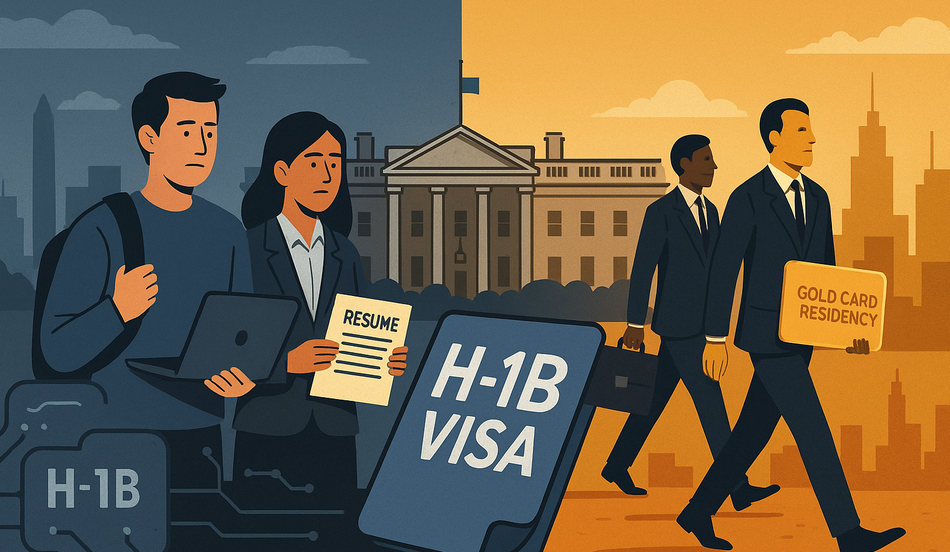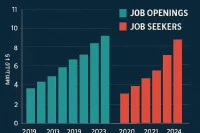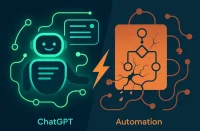In a dramatic policy shift, the Trump administration is signaling sweeping changes to the United States immigration system. Commerce Secretary Howard Lutnik sharply criticized the long-standing H-1B visa program, calling it “terrible” and pledging reforms that would restrict the flow of skilled foreign workers. At the same time, officials are floating a new proposal: a so-called “gold card” residency scheme designed to grant fast-track permanent residency to wealthy investors who pour capital into the American economy.
The developments mark a striking departure from earlier years, when Donald Trump defended the H-1B program and even backed Tesla CEO Elon Musk, who publicly vowed to “go to war” to protect it.
Rising Criticism of H-1B
The H-1B program, created in 1990, has long been a key pipeline for U.S. companies seeking to fill specialized roles in science, engineering, and technology. Each year, 85,000 visas are issued, the majority to Indian nationals, who account for more than 70% of all recipients. Chinese nationals hold roughly 12%, making the two countries the dominant suppliers of skilled workers under the program.
Critics argue that companies exploit H-1B to cut labor costs and avoid hiring American workers. Concerns escalated after allegations—later denied by Walmart—that an executive accepted bribes to hire Indian tech professionals over Americans. The controversy prompted Republican Senator Mike Lee to ask publicly on social media: “Is it time to pause H1B visas?”
Lutnik echoed these concerns, asserting that the current framework is “broken” and undermines U.S. workers. He pointed to cases where companies rely heavily on imported talent instead of investing in local recruitment and training.
From Skills to Capital: The “Gold Card” Proposal
Alongside criticism of H-1B, the administration is advancing a new idea: the gold card residency program. Under the plan, wealthy investors who commit substantial funds to the U.S. economy could bypass years of waiting for green cards.
The concept mirrors residency-for-investment schemes already in place in countries such as Singapore, Portugal, and the United Arab Emirates. These programs offer permanent residency, and in some cases eventual citizenship, to individuals who invest in real estate, businesses, or government bonds.
“The gold card is about attracting capital and creating jobs,” Lutnik said. “We want people who bring investment into America, not just those who take jobs away from Americans.”
If enacted, the proposal would represent a profound shift: from a “skills-first” immigration system to a “capital-first” model.
Supporters and Critics Weigh In
Supporters of the gold card argue that it could deliver a fresh stream of investment at a time when the U.S. economy faces global competition for capital. By drawing high-net-worth individuals to American shores, the government hopes to spur job creation, strengthen business confidence, and enhance innovation.
“This could be a game-changer for attracting global wealth,” said one New York-based investment advisor. “The U.S. already has a brand as a safe haven. Offering residency in exchange for investment only reinforces that image.”
But critics warn that the plan risks creating a two-tier system: one pathway for the wealthy and another for everyone else. Immigration advocates argue it undermines fairness and equity, privileging billionaires while tightening rules for skilled workers who form the backbone of U.S. industries like tech, healthcare, and finance.
“America is sending a dangerous message,” said an immigration attorney in California. “We no longer want the world’s best and brightest minds unless they come with a checkbook.”
Competing for Global Talent?
Post your openings on WhatJobs and reach top professionals in tech, healthcare, and finance—whether local or international.
Post a Job Now →Impact on U.S.–India Migration Corridor
For India, the world’s largest source of H-1B workers, the shift carries profound consequences. Indian nationals have long relied on H-1B as a pathway to permanent residency and eventual citizenship. With green card backlogs already stretching decades for some applicants, further restrictions could destabilize thousands of families.
“If the H-1B tap is turned off while gold cards expand, Indian IT professionals will face unprecedented uncertainty,” said a Bangalore-based analyst. “This could disrupt careers, delay family reunification, and alter the future of India–U.S. migration.”
U.S. technology firms also stand to feel the effects. Companies from Silicon Valley to Wall Street depend heavily on Indian engineers, data scientists, and healthcare professionals. Any reduction in H-1B allocations could intensify labor shortages, drive up wages, or push firms to relocate operations overseas.
Political and Economic Context
The Trump administration’s push comes amid heightened debate over immigration policy ahead of the 2026 midterm elections. For Trump’s political base, the move reinforces his “America First” message, prioritizing domestic workers over foreign talent.
At the same time, shifting toward investor-driven immigration reflects global trends. Countries facing slowing growth and rising fiscal pressures increasingly turn to wealthy migrants as a source of capital. The U.S., however, has historically emphasized skills-based immigration rather than wealth.
Economists note that while investor visas may bring new capital, they do not necessarily guarantee long-term job creation. “Attracting billionaires doesn’t always mean creating sustainable employment,” said an economist at Georgetown University. “We should be cautious about equating money with merit.”
The Road Ahead
The administration has not yet released a detailed legislative proposal for either restricting H-1B visas or implementing the gold card. Lutnik emphasized that reforms will aim to “align immigration with U.S. needs,” but acknowledged that striking a balance between fairness, economic growth, and political realities will be difficult.
For now, business leaders, immigration lawyers, and foreign workers alike are bracing for uncertainty. If H-1B rules tighten while gold card pathways expand, America’s immigration landscape could undergo one of its most significant transformations in decades.
As one policy analyst put it: “The real question is whether America wants to welcome brains or billions. That choice will define the future of U.S. immigration.”
FAQs
1. What is the H-1B visa and who uses it most?
The H-1B is a U.S. work visa created in 1990 for highly skilled professionals in fields such as technology, engineering, and healthcare. Each year, 85,000 visas are issued. Indians account for over 70% of H-1B holders, followed by Chinese nationals at around 12%.
2. What is the proposed “gold card” residency program?
The gold card would offer fast-track permanent residency to wealthy individuals who make large investments in the U.S. economy, such as establishing businesses or funding infrastructure. It mirrors investor residency programs in countries like Singapore and Portugal.
3. Why is the U.S. considering these changes now?
The Trump administration argues that the current system allows companies to abuse foreign talent while sidelining American workers. Shifting toward capital-based immigration is seen as a way to attract global wealth and stimulate job creation.
4. How could this impact Indian workers and students?
Since Indians dominate H-1B allocations, any restrictions could disproportionately affect them. Families may face longer waits for green cards, careers could be disrupted, and the U.S.–India tech corridor could weaken. At the same time, wealthy individuals may gain faster access through gold card pathways, widening inequality.




